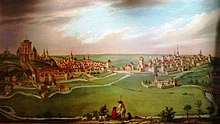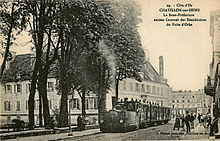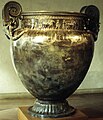Châtillon-sur-Seine
| Châtillon-sur-Seine | ||
|---|---|---|

|
|
|
| region | Bourgogne-Franche-Comté | |
| Department | Côte-d'Or | |
| Arrondissement | Montbard | |
| Canton | Châtillon-sur-Seine ( chef-lieu ) | |
| Community association | Pays Châtillonnais | |
| Coordinates | 47 ° 51 ′ N , 4 ° 34 ′ E | |
| height | 211-298 m | |
| surface | 33.15 km 2 | |
| Residents | 5,373 (January 1, 2017) | |
| Population density | 162 inhabitants / km 2 | |
| Post Code | 21400 | |
| INSEE code | 21154 | |
| Website | http://www.mairie-chatillon-sur-seine.fr/ | |
 Châtillon-sur-Seine, on the left the Saint-Vorles church |
||


Châtillon-sur-Seine is a French commune in the Côte-d'Or department with 5,373 inhabitants (as of January 1, 2017). The city is part of the Montbard arrondissement , is the capital of the canton of Châtillon-sur-Seine and the seat of the Pays Châtillonnais municipal association .
Châtillon is home to a well-known archaeological museum , including a. houses the Greek bronze crater of Vix .
geography
Châtillon, with an area of 33.15 km², is located on a limestone plateau with an average height of more than 300 m. The municipality is traversed by the Seine , which rises 40 km away in the Source-Seine area at an altitude of 446 m. The subsoil contains Burgundian stone ( pierre de Bourgogne ), which is mined as a building material in nearby quarries such as Étrochey . The native vegetation is lime-loving and rich in forest, the agricultural areas are used for growing grain and wine or as pasture land.
Châtillon is the center and the most populous city in the Châtillonnais countryside , which has 113 municipalities.
Protected areas
The Forêt de Châtillon-sur-Seine , with 8,875 hectares one of the largest domain forests in Burgundy, will form the Forêts de Champagne et Bourgogne National Park together with the forests of Arc-en-Barrois and Auberive from 2019 .
The Combe du Grand Prieur is a nature reserve of the ZNIEFF category .
history
Prehistory and Antiquity
The region shows numerous traces of settlement from prehistoric , pre-Celtic, Celtic and Gallo-Roman times: caves , erect stones and especially the oppidum of Mont Lassois , an important settlement center from the Bronze Age 6 km from the city and now the subject of research and excavations is.
During the Roman occupation, the Gallic people of the Lingons colonized the region. Châtillon, one of three fortified places ( fort ) in the area of Lassois, was already at the crossroads of several streets and thus in a strategically favorable location. Aerial photographs taken June 28, 1976 show traces of an archaeological site with square and circular structures that may be of Gallo-Roman origin. The settlement was devastated by the vandals in the 2nd century .
Early Middle Ages
In the crypt of the church of St-Vorles there is an oratory , which is said to have been founded by St. Didier in the first centuries AD and the first church schools are attested from the 6th century. In the 8th century, the residents settled what is now the town and fortified the castle hill that gave Châtillon its name. Under the Carolingians , the history of the region is shaped by the almost legendary figure of the Count Palatine Girart de Roussillon . In 886, the bishop of Langres Gilon de Tournus had the relics of the Holy Vorles de Marcenay transferred to Châtillon to protect them from the Norman invaders who devastated part of the country. Châtillon became an important pilgrimage site and the political, economic and religious center of Lassois. The present city then consisted of the two settlements "Chaumont", which was dependent on the Counts of Burgundy , and "Le Bourg", which was dependent on the Bishops of Langres. In the 10th century, Le Bourg became the seat of the Bailliage de la Montagne (“ Bailiwick of the Mountains”) with the first Counts of Valois, making it the capital of a prosperous region in which a cloth and metal industry developed.
In the 10th or 12th century, the duke's castle was built on the fort hill , which served as the residence of the dukes of Burgundy .
Late Middle Ages
From the 11th century onwards, its economic development made it one of the kingdom's 17 legal cities, where merchants and entrepreneurs freely pursued their activities: for 600 years, the trade in wool and tapestries from the suburb of Courcelles competed with that of Troyes . With the consent of the Bishop of Langres , the city received two fortifications from 1168 : one in the north for the Chaumont district, where the Burgundian Chancellor Nicolas Rolin owned a permanent house , the other in the south for the Bourg district.
In 1184, Châtillon was besieged by Philip II , Odo III. , the eldest son of the Duke of Burgundy, Hugo III. , captured.
Even before the spread of the Cistercians of Saint Bernard , important religious promoted the spread of religious institutions, in and around Châtillon abbeys of the Benedictines ( Molesme ), Carthusians ( Lugny ), Canon Regulars ( Oigny ), Templars and Hospitallers ( Bure , Épailly ) as well as the monastery were established Val-des-Choues . In 1136, Notre-Dame Abbey was founded on the initiative of Saint Bernard, who studied at Saint-Vorles before joining Robert von Molesme .
The Hundred Years War devastated the region and on July 15, 1475, Châtillon was almost completely destroyed by French troops.
Modern times
In the 16th century, Châtillon was on the side of the Catholic League . The Johanneskirche was built to support the Counter Reformation and consecrated in 1551. In 1576 the city was sacked by the Huguenot troops of the Duke of Alençon and hit by the plague a few years later . From 1586 a new district called Rue des Ponts was built between the two arms of the Seine, connecting Bourg with Chaumont. In 1594 the two districts elected a joint mayor and three years later the residents decided to demolish the castle. The three city walls were connected by bastions , of which there are still some remains despite the destruction after the French Revolution .
The monarchical authority was restored by Henry IV at the expense of communal freedoms, many medieval fortresses were demolished and replaced by pleasure palaces ( Autricourt , Montigny-sur-Aube ...) in a very short time . With the league, the medieval city revived, a new architecture shaped the cityscape and new open spaces emerged such as the Allée Rue du Cours l'Abbé in front of the Notre-Dame Abbey at the end of the 17th century. 1638 the union of the two parts of the city by a contract of the French King Louis XIII approved.
In the congress of Châtillon (February 5 - March 19, 1814), the allied powers in the war of liberation offered Napoleon I that he could keep rule over France within the borders of 1792. Napoleon refused the offer.
During the Second World War , the center of Châtillon in particular was destroyed in two air raids . On May 15 and June 15, 1940, the German Air Force bombed the city before it was occupied by the Wehrmacht . After heavy fighting, Châtillon liberated itself in September 1944, and the city center was rebuilt by 1960.
Population development
| year | 1962 | 1968 | 1975 | 1982 | 1990 | 1999 | 2006 | 2016 |
| Residents | 5518 | 6264 | 7383 | 7561 | 6862 | 6269 | 5837 | 5378 |
| Sources: Cassini and INSEE | ||||||||
traffic
Châtillon has a station on the Saint-Julien – Gray line , which went into operation in 1864. In 1994 passenger traffic was stopped, freight trains are still running. Between 1891 and 1933 a meter- gauge narrow - gauge railway ran from Châtillon via Aignay-le-Duc to Dijon .
The departmental roads D 965 and D 971 run through the city , the D 928 and D 980 end there. The next motorway junctions are on the A 5 in the north and the A 31 in the east.
Attractions

- Ruins of the castle Château des ducs de Bourgogne of the Dukes of Burgundy
- Princely burial place of Vix in the archaeological museum Musée du Pays Châtillonnais
- Romanesque church of Saint-Vorles
- Saint-Nicolas and Saint-Pierre churches, listed as historical monuments
- Abbaye Notre-Dame de Châtillon Abbey
- Former convent of the Couvent des Cordeliers
- Hôtel Philandrier, Renaissance style private house
- City Library , a listed building from the early 17th century
- Menhir in the Rathauspark
- Karst spring Source de la Douix
- Porte de Paris
Personalities
sons and daughters of the town
- Auguste Frédéric Louis Viesse de Marmont (1774-1852) was born and buried in Châtillon-sur-Seine
- Caroline Massin (1802–1877), seamstress, owner of a reading room and governess
- Désiré Nisard (1806–1888), literary historian
- Louis Paul Cailletet (1832–1913), physicist
- Edme Louis Gustave Tridon (1841–1871), journalist, revolutionary and member of parliament
- Léon Hatot (1883–1953), watchmaker and jeweler
- Kiki de Montparnasse (1901–1953), singer, actress, model and painter
- Bertrand Lavier (* 1949), sculptor and installation artist
People related to the city
- St. Bernhard von Clairvaux received his school education in Châtillon-sur-Seine in the 12th century
- Gustave Eiffel did an internship with his brother-in-law Joseph Collin in the foundry in 1855 after graduating as a chemical engineer
literature
- R. Joffroy: CHÂTILLON-SUR-SEINE, FORÊT Côte-d'Or, France . In: Richard Stillwell et al. a. (Ed.): The Princeton Encyclopedia of Classical Sites. Princeton University Press, Princeton NJ 1976, ISBN 0-691-03542-3 .
Web links
Individual evidence
- ↑ Gustave Lapérouse: L'histoire de Châtillon , Nabu Press, 2012, pp. 14/16.
- ↑ ZNIEFF 260015057, Combe du Grand Prieur
- ↑ Gustave Lapérouse: L'histoire de Châtillon , Nabu Press, 2012, pp. 21/35.
- ↑ Gustave Lapérouse: L'histoire de Châtillon , Nabu Press, 2012, pp. 46/47.
- ↑ Archéologia , No. 482, November 2010, p. 35.
- ↑ Gustave Lapérouse: L'histoire de Châtillon , Nabu Press, 2012, pp. 60/63.
- ↑ Gustave Lapérouse: L'histoire de Châtillon , Nabu Press, 2012, p. 71.
- ↑ Edme-Nicolas Tridon: Notice archéologique et pittoresque sur Chatillon sur Seine , Res Universis Paris 1992, pp. 14-21.
- ↑ Edme-Nicolas Tridon: Notice archéologique et pittoresque sur Chatillon sur Seine , Res Universis Paris 1992, p 78th
- ↑ Gustave Lapérouse: L'histoire de Châtillon , Nabu Press, 2012, pp. 77–113.
- ↑ Edme-Nicolas Tridon: Notice archéologique et pittoresque sur Chatillon sur Seine , Res Universis Paris 1992, pp. 39-43.
- ↑ Gustave Lapérouse: L'histoire de Châtillon , Nabu Press, 2012, pp. 117–124, 181–200.
- ↑ Gustave Lapérouse: L'histoire de Châtillon , Nabu Press, 2012, p. 116.
- ↑ Gustave Lapérouse: L'histoire de Châtillon , Nabu Press, 2012, pp. 240–249.
- ↑ Gustave Lapérouse: L'histoire de Châtillon , Nabu Press, 2012, p. 128.
- ↑ Edme-Nicolas Tridon: Notice archéologique et pittoresque sur Chatillon sur Seine , Res Universis Paris 1992, p. 9.
- ↑ a b c Entry No. IA21000035 in the Base Mérimée of the French Ministry of Culture (French).
- ↑ Edme-Nicolas Tridon: Notice archéologique et pittoresque sur Chatillon sur Seine , Res Universis Paris 1992, pp. 51, 62, 74.
- ↑ Gustave Lapérouse: L'histoire de Châtillon , Nabu Press, 2012, pp. 273-304.
- ↑ Gustave Lapérouse: L'histoire de Châtillon , Nabu Press, 2012, p. 309.
- ↑ Edme-Nicolas Tridon: Notice archéologique et pittoresque sur Chatillon sur Seine , Res Universis Paris 1992, p. 122.
- ↑ Gustave Lapérouse: L'histoire de Châtillon , Nabu Press, 2012, pp. 317, 323-325.
- ↑ Gustave Lapérouse: L'histoire de Châtillon , Nabu Press, 2012, p. 377.
- ↑ Gustave Lapérouse: L'histoire de Châtillon , Nabu Press, 2012, pp. 366, 368.
- ↑ Historique de la ville at chatillon-mairie.fr, accessed on May 20, 2019








